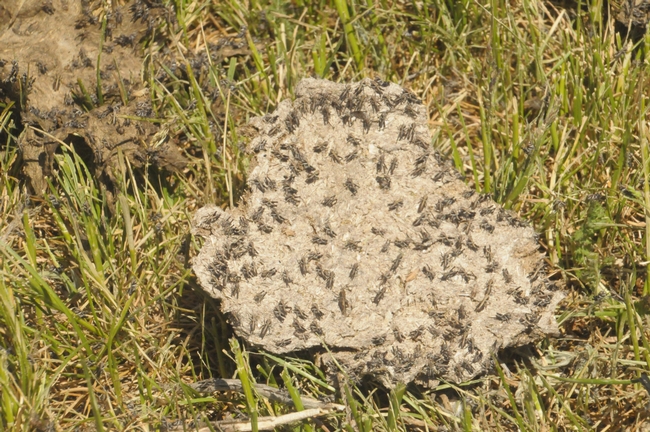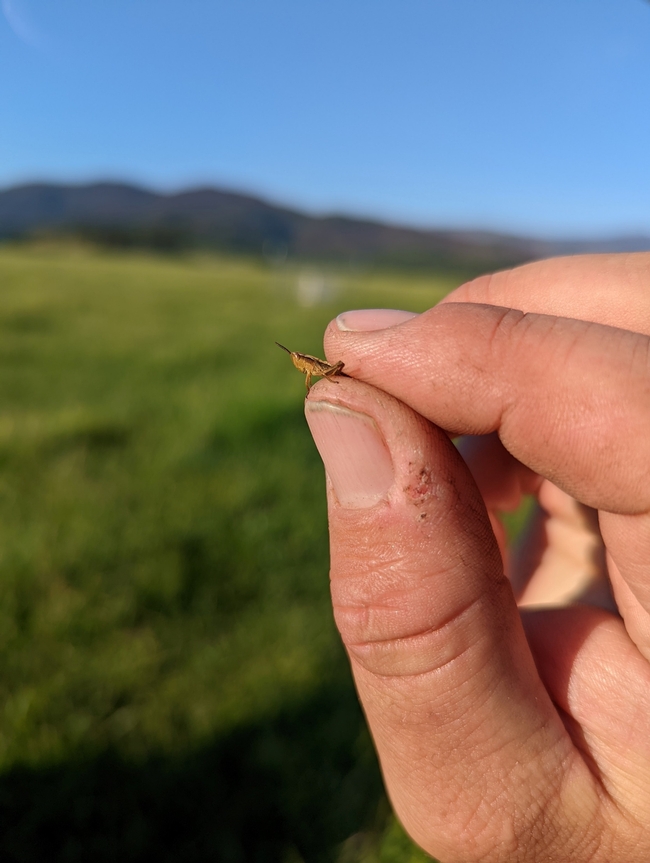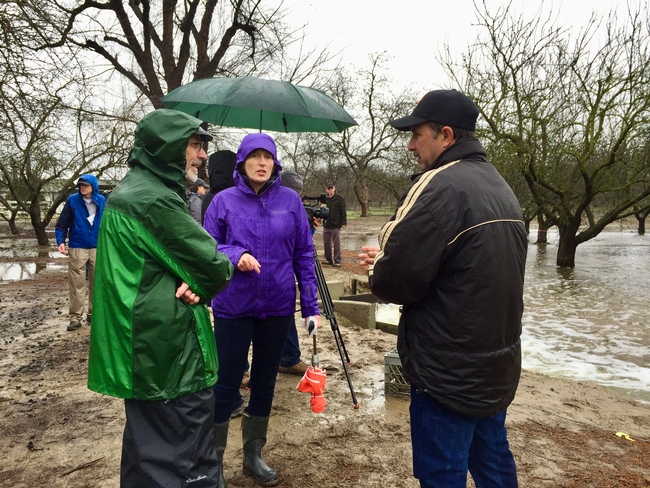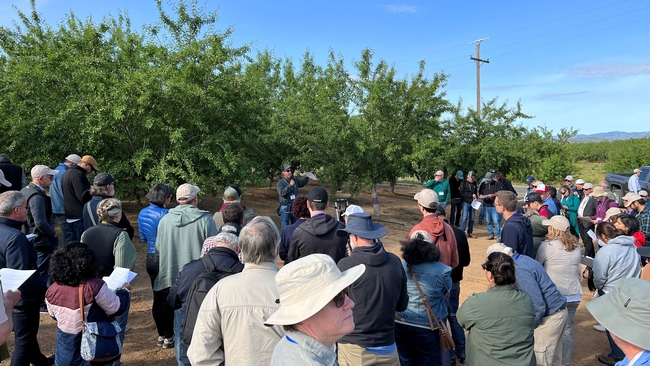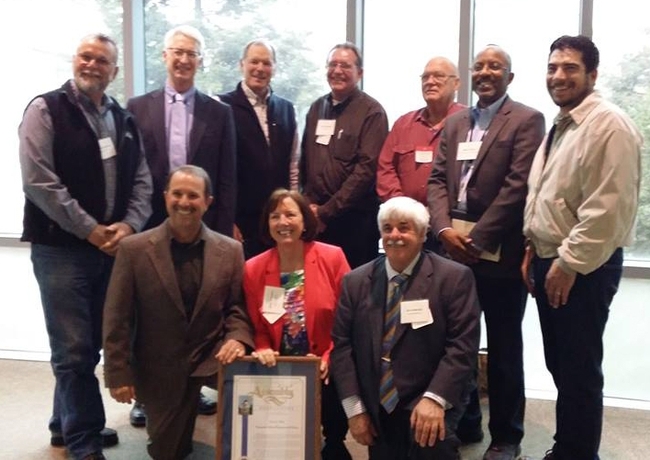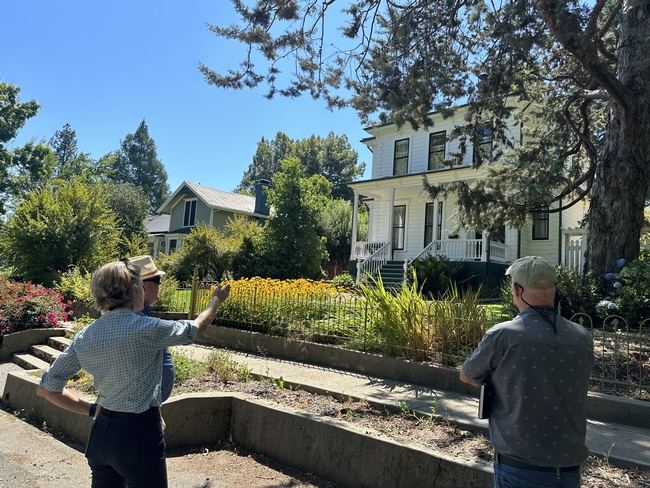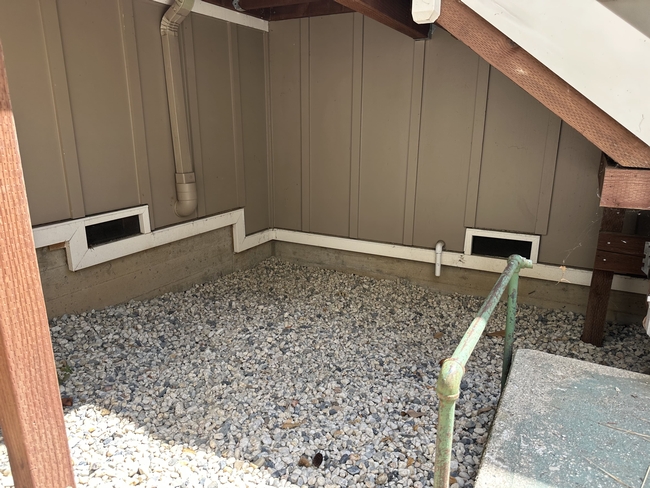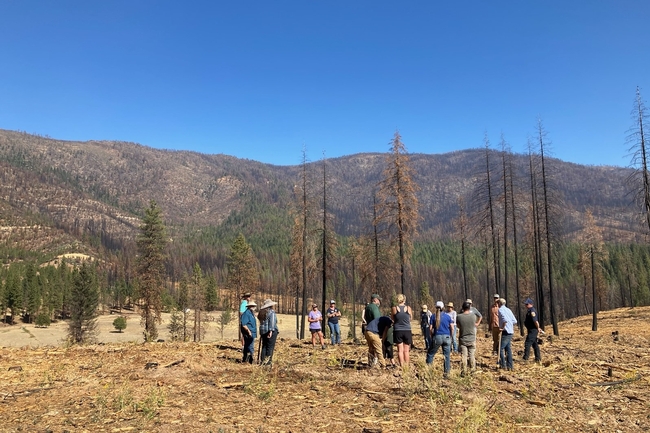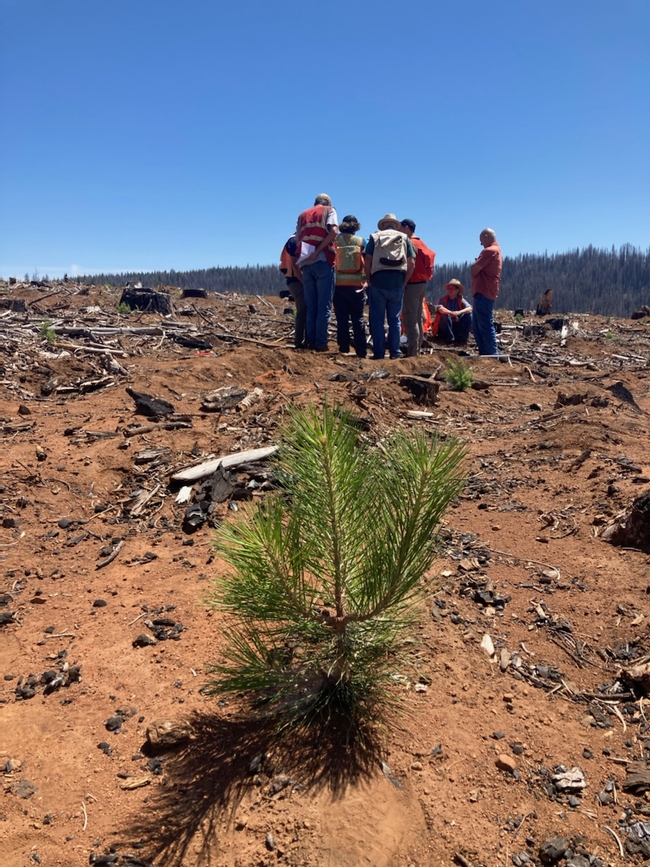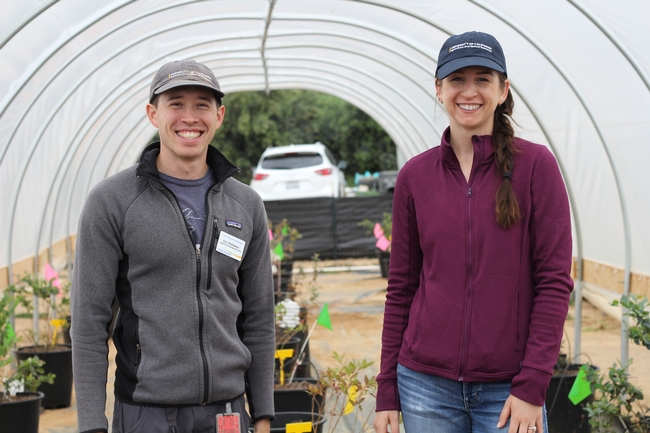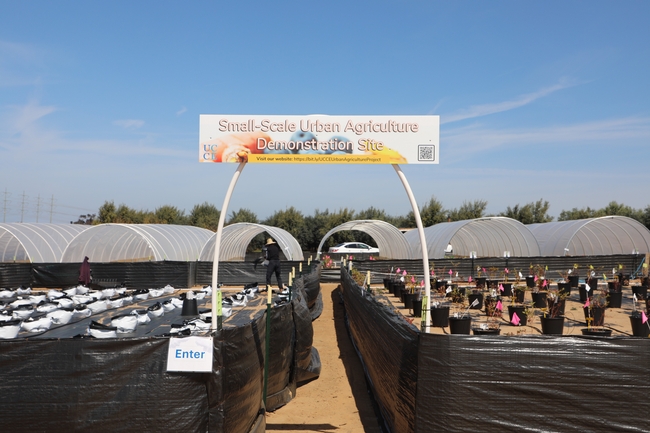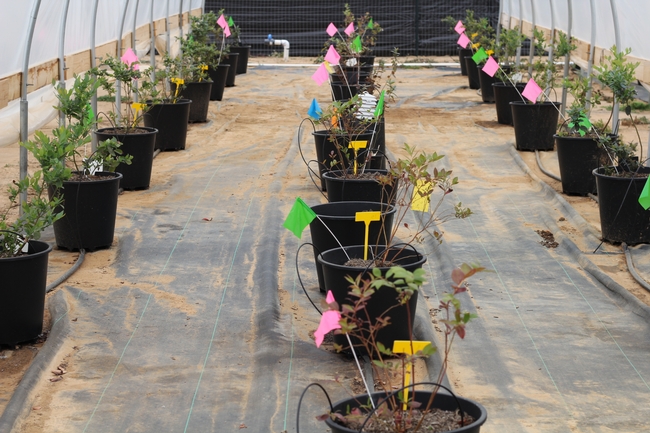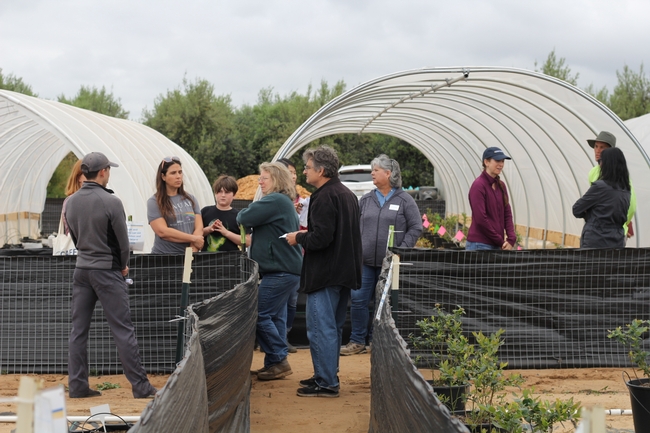Posts Tagged: Q
Grasshoppers gobble crops, farm profits
UCCE advisors share control, abatement strategies across Northern California
That buzzing noise in Northern California is the sound of grasshoppers chewing a path of destruction through crops and pollinator-friendly plants as they hop across an expanding area.
This is the fifth year in a row that massive numbers of grasshoppers have overrun Modoc County and “probably the worst I've seen yet,” said Laura Snell, a University of California Cooperative Extension livestock and natural resource advisor in Modoc County, located in the northeastern corner of the state.
In past years, Snell has heard from farmers who have lost up to 70% of their hay crop. This year, she is hearing of grasshopper damage from farmers who grow a wider array of crops, including onions and garlic – crops that the pests eschewed in past years.
“I've had an even broader group of producers contact me about damage,” Snell said. “Our local vegetable producers are being affected, decreasing farmers market and food hub products. Bee producers are not seeing good honey yields due to grasshoppers eating huge amounts of pollinator plants.”
Modoc County isn't alone. Lassen, Sierra, Plumas, Siskiyou, Tehama, Butte, Placer and Nevada counties are being invaded by grasshoppers.
“The county ag commissioners are circulating a survey to get an idea of other counties that may be affected,” Snell said. “Things like droughts and – I suppose, fires as well – would affect grasshopper migrations.”
While scientists don't know what's causing the explosive growth of grasshopper populations, there are some contributing factors, according to Tom Getts, UC Cooperative Extension weed ecology and cropping systems advisor for Lassen, Modoc, Plumas and Sierra counties.
In the past, grasshopper outbreaks seemed to be more isolated, and the populations tended to crash after a year or two. Getts said, “For whatever reason, the population cycle does not appear to have been broken, and they continue to have high numbers.”
Grasshoppers can consume 30% to 250% of their body weight per day, according to a fact sheet about grasshoppers, co-authored by Getts. While grasshopper nymphs walk, adults can fly 15 miles or more.
Getts and UC Cooperative Extension farm advisors have been giving presentations throughout the intermountain region on grasshoppers and the various control methods.
“The difficulty to controlling them is the scale and their ability to move,” Getts said. “The insects need to be targeted at a small growth stage for the tactics to be most efficacious. Once they are adults, it doesn't matter what one grower does to control them if their neighbor doesn't do anything.”
UCCE farm advisors in multiple counties are working on abatement options.
They recommend monitoring in April–May to control grasshoppers while they are still nymphs and susceptible to insecticides. Birds, spiders, rodents and fungi also can help keep the insects in check, but years of drought have reduced the fungi.
“The population of grasshoppers in the region have increased in size, scope and density in recent years,” said Rob Wilson, a UC Cooperative Extension agronomy and pest management advisor and director of the Intermountain Research and Extension Center in Tulelake.
The massive growth and spread of the pests is a problem because 30 pounds of grasshoppers can eat as much forage as a 600-pound cow can eat per day, he explained.
Part of the challenge of controlling grasshoppers is their changing behavior. In the past, grasshoppers would go away after a couple of years, now they persist. They used to thrive in dry fields, but last year, grasshoppers migrated 10 to 20 miles into irrigated fields, Wilson said.
Wilson, who has been monitoring grasshoppers near Tule Lake since early April, said that In some fields, there were 20 to 30 nymphs per square yard. More than eight nymphs per square yard can cause economic damage.
As if the grasshoppers themselves weren't enough of a nuisance, they attract other pests, including blister beetles.
“As the grasshopper population increases, you are bound to see an increase in all of the species that eat them over time,” Getts said. “Blister beetles cause terrible blisters when they get on your skin, hence the name, but they can also be problematic for livestock if they contaminate bales of hay.”
Getts recommends that growers take steps to prevent grasshopper populations from building over successive years. Growers should coordinate with neighboring growers to treat their fields due to the limited longevity and efficacy of treatments on individual fields.
[Editor's note: The sentence comparing the appetite of grasshoppers to that of cows was revised to clarify that grasshoppers aren't eating cows.]
Duncan’s research ‘blew up preconceived ideas,’ improved almond, peach, grape production
Roger Duncan, UCCE farm advisor in Stanislaus County, retires after 36 years
For more than three decades, tree fruit and nut growers have depended on the advice of Roger Duncan, UC Cooperative Extension pomology farm advisor in Stanislaus County, to improve their production practices. Duncan, whose research and extension program focused on almonds, peaches, grapes and other tree crops, retired July 1.
“Roger Duncan has been an extraordinarily relevant researcher for the predominant crops in Stanislaus County,” said Rep. John Duarte, owner of Duarte Nursery in Hughson. “His research has encompassed rootstock and variety selection, tree spacing, chemical inputs and spraying, fertilizers, pruning and replanting amongst other projects.”
Duncan began working for UC ANR in 1988 as a field assistant to Integrated Pest Management advisor Jim Stapleton after earning a master's degree in plant science and plant pathology from Fresno State and a bachelor's degree in the same subjects from UC Davis. In 1990, he became a UC Cooperative Extension in pomology farm advisor in Stanislaus County.
During Duncan's tenure, the planted acreage of tree and vine crops has tripled in Stanislaus County to nearly 1,900 farms on over 230,000 acres. His research has helped to improve production efficiency through improved rootstocks, crop varieties and production practices.
“Roger provides growers with resources and tools on nutrition, sprays, nutrient deficiencies, calendars, costs, pest management and other horticultural practices,” Duarte said. “His work has had significant impact on the productivity and quality of almonds, peaches and grapes. Breeders, universities, nurseries, growers and marketers have all gained from the wisdom and dedication of Roger Duncan.”
Growing up in Modesto, Duncan wasn't raised on a farm. “I had friends whose families farmed orchard crops, so I had some exposure,” he said. “I caught the Extension bug while working as a summer intern for the pomology advisors in the Stanislaus County UCCE office after I graduated with my B.S. That is what inspired me to return to school with the goal of being a pomology farm advisor.”
Reducing production costs
To help growers lower production costs, Duncan introduced orchard practices aimed at reducing hand labor and other inputs. As a result of his research, minimal pruning has become the norm in California almond production, reducing input costs and carbon output and increasing yield. He also improved monitoring and management techniques of established and invasive diseases and insect pests.
“The practical applications Roger brings to the grower community are invaluable,” said Mel Machado, Blue Diamond Almonds vice president for member relations and Stanislaus County almond grower. “His minimal pruning study stood growers on their heads. People had preconceived ideas about pruning. He blew that up. His research showed that after you get the tree's frame, all you need to remove are the dead and occluded branches. With the market depressed, we needed to cut costs. He said, ‘You don't need pruning.' Now I'm growing bushes.”
Art Bowman, a crop adviser with Salida Ag Chem, agreed that Duncan's pruning research had an impact. “Roger's pruning trial that lasted over 20 years was a much-discussed subject among growers,” Bowman said. “Growers' pruning practices definitely changed due to Roger's research, with early emphasis on structural development and, later in the tree's life, concentrating on tree accessibility and deadwood removal.”
In 1990, when Duncan joined UC Cooperative Extension, California had 408,700 acres of almonds, according to the California Agricultural Statistics Service. Now the state has over 1.5 million acres of almonds.
About 75% of the farms Duncan has served have 40 acres or less, farmed by “small” or “part-time” farmers, who needed to learn basic horticulture and pest management. Stanislaus County also is home to some very large, sophisticated growers, who Duncan has kept apprised of new technology.
“I believe that personal interaction offers the most memorable means of information transfer, which is why I held an average of 12-plus extension events per year, gave 18-plus extension presentations per year, and went on an average of over 75 individual farm calls per year,” Duncan said. He also provided information via videos, blogs, podcasts, radio shows, newsletters, news media and extension publications as well as commodity boards.
Along with Duncan's research, Bowman has appreciated his availability. “Roger was always ready to take a call, make orchard visits and listen to a grower's concern or problem,” he said.
In 1997, Duncan began hosting twice monthly Tree & Vine Integrated Pest Management breakfast meetings for pest control advisers and growers to discuss current and potential pest threats. These meetings have continued for 28 years.
He speaks ‘farmer'
Machado attributes much of Duncan's success to his communication skills. “His research is scientific and he speaks ‘farmer,'” he said.
Machado gave rootstock as an example. “Roger is my rootstock resource; he knows rootstocks better than anybody,” he said. “His rootstock trial is dirt simple. There's a different rootstock every five trees. You can see walking down the row the differences in the rootstocks.”
From his field evaluations, Duncan identified a complex hybrid rootstock that is highly tolerant to ring nematode, bacterial canker and salt toxicity. He found other hybrid rootstocks that boost crop yield while reducing risk from soil chemistry and soil-borne disease challenges, enabling almonds to be grown in the marginal soils on the west side of the North San Joaquin Valley. To help growers choose the appropriate rootstock for their soil, he wrote a comprehensive ANR publication, made a video and worked with the UC Fruit & Nut Center to create an interactive rootstock comparison website.
Over the last 15 years, use of hybrid almond rootstocks has increased dramatically. Burchell Nursery now sells approximately 40% of their trees on hybrid rootstock compared to less than 5% of almond trees 15 years ago, and more than 95% of Duarte Nursery almond trees are on hybrid rootstocks, according to Duncan.
“We've worked with Roger for years, back when he didn't have a mustache and then when he had a mustache,” said Robert Longstreth, who grows almonds, walnuts and cherries.
“Roger does research in the area you need, not frivolous stuff that you don't need,” said Longstreth, who has benefited from Duncan's research on pruning, rootstocks, irrigation timing, plant nutrition and disease control. “He's thought very highly of by almond growers. When he has something to say, people listen.”
The UCCE farm advisor has overseen long-term trials to learn how to design and maintain an almond orchard to capture early production, maintain long-term yields and maximize profits. “In the first 17 years of the orchard design project, I increased cumulative net profits by up to $14,000 per acre, including increased yield while reducing labor and carbon inputs,” Duncan said.
Influenced by Duncan's tree-spacing research results, growers have increased almond tree density by 20% per acre statewide, leading to higher crop yields, longer-living orchards and better farm economic sustainability.
As California's expert on almond rootstocks and almond orchard design, Duncan has taught the subjects for the UC Almond Production Short Course, was lead author on the UCANR publication “Almond Rootstocks,” wrote the rootstock chapter, and co-authored the orchard design chapter of the UC Almond Production Manual. He was invited to Chile, Spain and Australia to share his expertise with growers there.
Expanded programs for kids and gardeners
In addition to being a farm advisor, Duncan served as director of UC Cooperative Extension in Stanislaus County from 2011 through 2013 and again from 2017 through 2020. As the UCCE county director, he acquired new county funding to hire a 4-H youth development program representative in 2018 to provide more learning opportunities for local, underrepresented children.
That year, he also acquired county funding to hire a full-time Master Gardener coordinator and launched the first UC Master Gardener Program in the county.
“I felt very lucky to serve as an advisor in the same county where I was born and raised,” Duncan said. “I am most proud of the trust I have developed with the growers and other clientele.”
Professional awards
Recently, Duncan's peers at UC ANR honored him with a Distinguished Service Award for his outstanding extension program, which gave growers the data and confidence to adopt orchard practices that have bumped up the productivity and economic value of California almond orchards.
The popular breakfast meetings to discuss pest management earned Duncan and his UC Cooperative Extension farm advisor colleagues the Entomological Society Award of Extension Excellence and the California Department of Pesticide Regulation's IPM Innovator Award. The California Legislature also recognized the breakfast club's commitment to sustainable pest management.
Recognizing Duncan's extraordinary contributions, the university recently granted him emeritus status.
“I have a lot of respect for the other farm advisors, but Roger is at the top of the pile,” said Machado, who has served on Almond Board committees with Duncan and known him since he joined UC Cooperative Extension. “I'm going to miss him. You can absolutely count on him.”
Congressman and nurseryman Duarte added: “While he will be sorely missed by us in his role of pomology advisor for the University of California, we hope that he keeps his interest, and continues to influence the food production industry in the Central Valley.”
Simple tasks make big difference in preparing for wildfire, smoke
UC ANR Fire Network compiles expert advice on preparedness, evacuation tasks
The explosive growth of the Park Fire in Northern California was fueled by recent, intense heat waves and extremely dry vegetation – conditions seen at many locations across the state.
Given the potential for wildfire and smoke impacts during what is expected to be a protracted “fire season,” California residents should think ahead and complete emergency preparations: https://ucanr.edu/sites/fire/Preparedness/.
“If you are concerned that you or someone you know could be affected by fire or smoke, now is the time to take simple steps to prepare,” said Yana Valachovic, University of California Cooperative Extension forest advisor for Humboldt and Del Norte counties.
Valachovic and other members of the UC Agriculture and Natural Resources Fire Network are urging community members to tackle small but significant tasks to minimize potential fire damage. Many of these tasks can be finished in a weekend, such as:
- Clean debris from your roof and gutters.
- Inspect the area around your home and nearby structures and remove all combustibles (dead grass, plants, woody mulch, stored wood, etc.) in the first 5 feet, including under decks and stairs.
- Inspect the foundation, under-eave, and gable-end vents for holes and damage; add a layer of finer metal-mesh screens (1/8” mesh) to the vents to prevent ember penetration.
- Inspect the garage door bottom seal to make sure embers can't blow under the door.
- Replace the first 5 feet of wooden fences that attach to buildings with a noncombustible panel or gate.
A recently published report, “Retrofitting a Home for Wildfire Resistance,” also can help residents prioritize the measures that are most cost-effective and fit their budget.
Six things to do, six hours before evacuation
As evacuation warnings are issued for local communities, there are six important things to do in advance of an actual evacuation order, according to Valachovic:
- Close windows, pet doors and skylights.
- Move inside patio cushions, brooms and door mats; tie open wooden gates that attach to the house or deck to prevent a fire from traveling from the fence to the house.
- Relocate the barbecue propane tank away from home.
- Stage buckets of water and garden hoses in visible locations.
- Dress for evacuation: cotton clothes, sturdy shoes, hat and face protection and leather gloves.
- Put your “go bag” in your vehicle.
The UC ANR Fire Network website also includes downloadable checklists – in English and Spanish – for your go bag (https://ucanr.edu/sites/fire/Safety/Evacuation/Preparing_a_Go-Bag/) and for a host of important pre-evacuation tasks for your household, property, pets and livestock (https://ucanr.edu/sites/fire/Safety/Evacuation/).
“We want communities to be wildfire-prepared – not scared,” Valachovic emphasized.
Smoke exposure a significant public health concern
Hazardous smoke can blanket wide swaths of California – and much of the Western U.S. – during ongoing wildfire events. A primer on harmful health effects, a list of tips for reducing smoke exposure, and other resources and links can be found on the UC ANR Fire Network site: https://ucanr.edu/sites/fire/Safety/Air_Quality_and_Smoke/.
“If there's smoke in the forecast for the next few days, I would keep an eye on my local air quality at fire.airnow.gov,” said Katie Low, statewide coordinator for UC ANR's Fire Network. “And if the AQI – Air Quality Index – is high, I would limit my outdoor activity, wear an N95 mask if I do go outside, and run my air purifier.”
For instructions on making a DIY air cleaner, creating a “clean air space” in your home and fitting an N95 mask properly, visit the California Air Resources Board's “Smoke Ready California” page: https://ww2.arb.ca.gov/smokereadyca.
Another useful tool is the crowd-sourced #FireMappers fire activity map – powered by the National Alliance for Public Safety GIS Foundation, GISCorps, and CEDR Digital Corps – accessible through the UC ANR Fire Network site: https://ucanr.edu/sites/fire/Safety/Current/.
UCCE report: Local forest restoration teams effective at rapid response
Quickly planting trees after wildfires crucial for communities, ecosystems, carbon goals
As the climate crisis fuels more high-severity wildfires, many forests – adapted to bounce back from frequent but less-intense fires – are struggling to recover quickly.
“In a lot of locations, forests in the Sierra Nevada that burn at high severity are not regenerating on their own,” said Susie Kocher, University of California Cooperative Extension forestry and natural resources advisor for the Central Sierra. “They need to have living trees to drop seeds; if everything dies in an intense fire, then there's a high likelihood in those locations that trees might not return for a while.”
According to Kocher, a forest may take multiple decades to grow back on its own, seeding in very slowly from the edges of a burn. To speed up that regeneration process, a pilot program of local “Emergency Forest Restoration Teams,” or EFRTs, have been helping forest landowners rapidly remove dead trees, plant new seedlings and expedite other vital tasks after wildfires.
Kocher is a co-author of a recently released report evaluating the EFRTs, which appear to be effective in assisting often-overwhelmed private landowners navigate competitive funding programs and complicated permitting pathways after wildfire. Small private landowners in California own 7 million acres, comprising 22% of forested land across the state.
“None of our current assistance programs were really designed to rapidly respond to high-severity fire disasters,” Kocher said. “And we're just getting so much more high-severity fire now that there needed to be a different way of helping people, besides business as usual.”
Lead agencies improve coordination of restoration efforts
Drawing from a successful model in Washington, Kocher and other members of the Governor's Forest Management Task Force recommended the formation of EFRTs in 2019 and this recommendation made it into the California Wildfire and Forest Resilience Action Plan of 2021.
Following the Caldor, Dixie and Tamarack fires during that year, disaster relief funds from CAL FIRE and the U.S. Forest Service enabled the establishment of pilot EFRTs in each of the affected regions. A key innovation was designating a local lead agency to coordinate restoration efforts: the El Dorado Resource Conservation District (Caldor), the Feather River Resource Conservation District (Dixie) and Alpine County (Tamarack).
“The idea is that one well-established local agency gets the funds to carry out all the reforestation work,” Kocher said. “They find contractors for the landowners and plan and carry out all the work needed, including dead tree removal, site preparation and replanting; this helps it be more coordinated across the landscape and reduces competition for contractors.”
“Also, for most of that work, there's no cost to the landowner – which is a huge benefit to them, because these things can get really expensive, like many thousands of dollars an acre,” Kocher added.
Although there was an initial steep learning curve for the local lead agencies on the complexities of reforestation and the maze of required permits, they quickly executed a significant number of forest restoration treatments. Within two years, the three pilot teams had collectively completed over 2,500 acres of dead tree removal and 1,400 acres of conifer planting.
“The overwhelming benefit of the pilots was that a lot of work got done on the ground, that otherwise would not have been done – at least not in the timeframe that was made possible by the EFRTs,” said Daylin Wade, a UCCE staff research associate and co-author of the recent report, who synthesized feedback from interviews of professionals involved in the program.
Rapid reforestation better financially, ecologically
Both Wade and Kocher underscored how the EFRTs were crucial in completing restoration tasks in a timely manner. Removal of dead wood becomes trickier and more expensive over time, as the trees decay and are dangerous to cut down.
“A major accomplishment was getting trees out of there while it was both safe and economically viable to remove those trees – and getting trees in the ground before shrubs dominate the site,” Wade explained.
It's also imperative to quickly remove the dead trees to reduce the fuel load and minimize the chances of re-burn in the area.
“If you're not doing this work, then you're actually endangering the investment that you're putting into rebuilding communities that burned, because they're in danger of burning again if you have huge piles of dead trees everywhere,” Kocher said.
Furthermore, expediting those tasks helps restore the forest cover that is crucial for sequestering carbon and achieving the goals of California's sweeping climate action plan – such as attaining carbon neutrality by 2045.
“We have very ambitious carbon goals for our forests in California, and so reestablishing them – even on private lands – is a public benefit,” Kocher said.
Evaluation of EFRTs by UC Cooperative Extension continues
In addition to enumerating the progress of the three EFRT case studies, the evaluation report also lists recommendations to further enhance the program, such as securing rapid and flexible funding for future EFRTs, improving guidance for local lead agencies and streamlining permitting processes.
The authors also stressed the need to expand opportunities for the commercial sale of woody material in the aftermath of a wildfire event. Selling logs and wood chips reduces the volume of material that would need to processed onsite by the EFRTs and their contractors, thereby defraying some of the costs for that work.
But there simply hasn't been a sufficient market for that woody biomass.
“It's a big barrier,” Kocher said. “If we had a healthier timber market, it would be easier to make this stuff pay its own way and be less of a subsidized endeavor.”
UC Cooperative Extension's EFRT evaluation work – made possible by funding from the U.S. Forest Service State, Private and Tribal Forestry, Region 5 – will continue for the next couple years. On the heels of this first report, Wade will next gather and summarize feedback from private landowners on whether the EFRTs are meeting their goals.
And, later this summer and fall, researchers will begin assessing the ecological success of the plantings in the restoration areas, surveying seedling survival and gauging the volume of competing vegetation.
“It's hugely encouraging that we've gotten all these trees in the ground, but it's not the end of the process – it's just the beginning,” Kocher said. “Trees and forests need to be maintained over time, so this next step will let us see how successful that has been, and if there are additional steps needed to actually ensure that these trees succeed and thrive.”
The full report, dedicated to the memory of report co-author and UCCE advisor Ryan Tompkins, can be found at https://ucanr.edu/efrt.
Could empty lots be growing food, economic opportunity?
UCCE scientists study feasibility of specialty crops for small urban growers
The vacant lots around your neighborhood could be growing fruits and vegetables and making local produce more accessible – while reducing energy needed to transport and distribute the food. Could turning those empty lots into small farms also become opportunities for economic development?
To answer this question, a team of researchers from University of California Cooperative Extension in San Diego County are investigating the economic feasibility of growing high-value specialty crops in urban settings like vacant lots. The project – led by Eric Middleton, UCCE integrated pest management advisor for San Diego, Orange and Los Angeles counties – is currently in progress at The Flower Fields in Carlsbad, a seasonal attraction for locals and tourists.
Tucked away in the back of the field is the Small-Scale Urban Ag Demonstration Site where Middleton and his team established a small farm on approximately 17,000 square feet, starting fall 2023. Funded by the U.S. Department of Agriculture National Institute of Food and Agriculture, the farm is designed to evaluate containerized production both outdoors and under high tunnels.
Growers don't necessarily need land, just space
High tunnels, also referred to as hoop houses, are semi-permanent structures that act similarly to greenhouses in providing a controlled environment. For the experiment, Middleton will compare cost, effort and durability of two types of high tunnels: one made of steel and the other out of PVC pipes.
“We want to give interested growers information on as many options as we can,” said Middleton, who explained that the project is motivated by the challenges of urban settings, including limited space and lack of arable land.
In the trial, they are growing turmeric, ginger and blueberries. The high-value crops were selected because of their potential to earn a profit. Data evaluating plant variety, soil mix, fertilizer, growth performance, yield and pest and disease pressures will be collected and reported when the project concludes in 2026.
As the crops develop in containers – blueberries in pots and turmeric and ginger in grow bags – Middleton pointed out the mobility aspect of the study, noting that growers don't necessarily need land, just space.
Whether it's a backyard or a rooftop, containerized production means easier transport, especially since vacant land doesn't always remain vacant forever and urban lots may often need soil remediation. Growing in containers solves the anticipated problem of having to relocate.
Where to set up shop in San Diego County
Jan Gonzales, project coordinator and community education supervisor for UCCE San Diego County, is leading the effort to identify available urban land in San Diego County as well as the policies and procedures for growers to access these spaces.
Gonzales is collaborating with community members who are working on similar projects to identify space for prospective growers.
“This has been done before for different objectives and for specific areas in the region, but the information was either project-specific and not publicly available, or not easy to find,” Gonzales said.
Having spoken with people associated with previous or ongoing agricultural land mapping projects, Gonzales has agreed to coordinate and facilitate an advisory work group to discuss areas of potential collaboration and develop project efficiencies. She anticipates holding the first group meeting before the end of the summer.
A production guide to help community members re-create the project
The ideal audience for a study like this is anyone who wants to grow specialty crops, according to Lindsey Pedroncelli, interim director of UC South Coast Research and Extension Center in Irvine, who worked on the project alongside Middleton when she was a staff research associate with UCCE San Diego.
“If you're a new grower or a grower who wants to diversify your crop production, what we're learning here can be applied to you,” said Pedroncelli.
Pedroncelli has been instrumental in bringing the experiment to life and documenting its step-by-step workflow thus far. The production guide, which is being created as the study unfolds, will include instructions detailing how to replicate the experiment from the ground up. Currently, it contains information on how to design your farm, the materials to buy, building structures, irrigation setup and crop management.
The most intriguing open question, whether the operation is profitable, is the driving force behind the production guide and will certainly be addressed, Pedroncelli said.
Book a tour and visit the farm
When visiting the farm, you'll encounter three varieties of blueberries: Star, Snowchaser and Misty. Snowchaser has been a top producer since it was planted in January, but the variety is known to be an early season producer.
Using only one variety of each, the turmeric and ginger were planted in late March-early April. With some unanticipated cold weather in San Diego County, both crops struggled when transitioning out of dormancy, leading to very slow progress, which the team is still navigating today.
Visually, Middleton and his team have noticed differences between the crops growing under the high tunnels versus those grown outdoors, although the data has not been analyzed to confirm or explain notable differences.
Attempting to demonstrate how to profitably grow high-value crops in urban settings using limited space and resources, Pedroncelli said she hopes this study will also encourage people to grow culturally significant crops for their communities.
To tour the Small-Scale Urban Ag Demonstration Site at The Flower Fields in Carlsbad, email Eric Middleton at egmiddleton@ucanr.edu with "Urban Agriculture Demonstration Site Tour" in the subject line.
To learn more about the project and its progress, visit https://ucanr.edu/sites/socalIPM/Small_Scale_Urban_Agriculture_Project_/.



